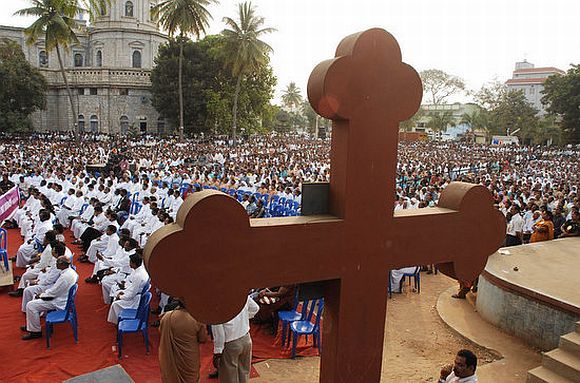 | « Back to article | Print this article |

With Union Minister Kiren Rijiju stoking a controversy by saying that the Hindu population was falling while minorities are flourishing, Rediff.com's Syed Firdaus Ashraf studied the 2001 and 2011 Census data to track the demographic changes in the North-East.
On Monday, Union Minister of State for Home Kiren Rikiju set off a controversy when he tweeted that 'the Hindu population is reducing in India because Hindus never convert people. Minorities in India are flourishing unlike some countries around'.
Naturally, condemnation of his statement was quick to follow, but what was lost in the uproar was that the minister was reacting to the Arunachal Pradesh Congress Committee's accusation that 'the Narendra Modi government was trying to convert Arunachal into a Hindu state' and charged that 'the rich tradition and culture of the indigenous tribe of Arunachal Pradesh was under stake under BJP rule'.
Rijiju, a practising Buddhist, hails from the border state, and represents Arunachal West in the Lok Sabha.
Following the controversy, a quick fact check of the population figures of various religious communities in the northeast.
NOTE: These figures pertain only to the North-East states, since Rijiju was rebutting the Congress claim pertaining to Arunachal Pradesh.
In Arunachal Pradesh, which the Congress has accused the BJP of trying to convert into a Hindu state, the figures are revealing.
As per the 2001 Census, the Hindu population in the state was 379,935 while Christians numbered 205,548.
And as per the 2011 Census, the latest count of population figures available, Christians had more than doubled in number and overtaken Hindus in the state.
While their number had grown to 418,732, a leap of 213,184 over 10 years, Hindus numbered 401,876, having grown by 21,941 over 10 years (162,815).
Thus, in 2011, Arunachal Pradesh joined the other North-Eastern states which had a Christian majority -- except Assam, where the community comes at third slot, after Hindus (19,180,759) and Muslims (10,679,345). Christians in Assam number 11,65,867, and in Tripura.
In Meghalaya, Mizoram, Nagaland, Christians have been the single largest community.
In Manipur, they were the second largest community in the 2001 Census (737,578) after Hindus (996,894).
In 10 years, their number has grown to 11,79,043, a difference of 441,465, while the Hindu population went up to 11,81,876, a growth of 184,982.
The Christian population is just 2,833 short of the Hindu numbers.
In Meghalaya, the 2011 Census data shows that there are 22,13,027 Christians and 342,078 Hindus out of the total population of 29,66,889.
Ten years ago, Christians numbered 16,28,986 while Hindus were 307,822. Over 10 years, Christians had grown by 584,041 while Hindus had increased by 34,256.
In Mizoram, the Hindu population has decreased as per the 2011 Census data.
In 2001, there were 31,562 Hindus in the state. However, their numbers dropped by 1,426 to 30,136 in 2011.
On the other hand, the Christian population had grown from 772,809 in 2001 to 956,331 in 2011, an increase of 183,522 in the same period.
Nagaland is the only North-East state where the Christian population has decreased.
In 2001, Christians numbered 17,90,349, which decreased to 17,39,651 in 2011, a fall of 50,698.
The Hindu population here was 153,162 in 2001 which increased to 173,054 in 2011, an addition of 19,892.
Tripura is one North-East state where the Christian population is growing at a slower rate than Hindus.
In 2001, the Christian population was 102,489 which increased in 2011 to 159,882, an addition of 57,393.
In the same period, the Hindu population grew from 27,39,310 to 30,63,903, a rise of 324,593.
Kindly note: Image published only for representational purposes.